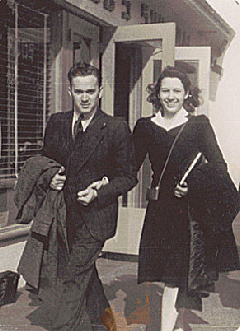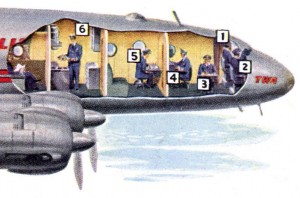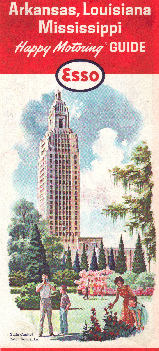
Not just cutaway drawings, but king of practically all other areas of commercial illustration through the 1930s-1960s, it seems.
Soltesz’ life is told in detail by his son, Ken Soltesz (Frank Soltesz: Biography of a Commercial Illustrator). If you can somehow define the “look” of commercial illustration during that great mid-century period in the United States, that look was defined by Frank Soltesz. He infused “mere” commercial illustration with grace, precision, mood, and authentic artistic talent.
Ken Soltesz tells many great anecdotes about his father, including this one that I found particularly touching.
I remember as a boy going out through the backyard to visit daddy in his studio. He would let me sit quietly and watch him, and he would sometimes try to explain to me the types of paints and brushes he used. On a few occasions, he would sit me on his lap, load the brush with paint, and let me paint a few small strokes on the job he was working on. Then when the picture appeared in a magazine a few months later, he would show it to me and say “Look what we did”.
Frank Soltesz: From Penna. to Mad Avenue
As Ken Soltesz recounts, Frank Soltesz was born on June 14, 1912 in Derry, Pennsylvania, one of eight children born to Jacon and Susana Soltesz. Even as a young child, Soltesz demonstrated the promise of artistic talent. After clearing blackboards at school, he would draw festive pictures in colored chalk. He won a number of Pittsburgh-area art contests as a young boy, too.
Soltesz’ first big push into becoming a professional artist came around 1933 when he enrolled in the Art Institute of Pittsburgh. After two years at AIP, he got a job at the Pittsburgh Press and then later at advertising agency Rayart Studios.
In 1945, Soltesz got another big push. Jack Frye, President of TWA, saw Soltesz’ work and offered him a job doing TWA’s magazine ads.
Later on, another valuable connection was established. William Gale, the art director at big Mad Avenue advertising firm Batten, Barton, Durstine and Osborn, Inc. (BBD&O) gave Soltesz a job.

The Armstrong Cork Cutaways
The famed Armstrong Cork advertisements, renowned for their attention to style as well as substance, came about from this BBD&O connection. As Ken Soltesz recalls:
One of the first accounts that Bill Gale gave to Frank was that of the Armstrong Cork Co. To illustrate how Armstrong products were used in everyday life, they had Frank paint factories or buildings with parts of their walls removed to show the operations inside. Between 1947 and 1951, he drew 29 of these. They appeared in the Saturday Evening Post and later were reprinted in some encyclopedias. They attracted much attention to Frank’s artistic ability, and greatly furthered his career.
 It would be a mistake to think that Soltesz’ talents ended with the Armstrong Cork Saturday Evening Post series. A partial list of accounts and publications associated with Soltesz includes:
It would be a mistake to think that Soltesz’ talents ended with the Armstrong Cork Saturday Evening Post series. A partial list of accounts and publications associated with Soltesz includes:
- Allegheny Ludlum Corporation
- Avco Manufacturing
- Caltex Petroleum, Ethel Corporation
- General Electric
- General Motors
- Goodyear Aviation
- Goodyear Tire and Rubber
- Merritt-Chapman & Scott
- Orangeburg Pipe
- Philadelphia Electric Co.
Not only that, but Soltesz’ work appeared in all the major periodicals of the day: Life, Colliers, Saturday Evening Post, Esquire, Sports Illustrated, Forbes, Fortune, Time, Business Week, U.S. News and World Report.
In this age of TV, cable, satellite, and Internet, it is hard for those too young to know–and even for those old enough to remember–that incredible importance of these publications to the American public.